Sola-Busca Tarocchi
The Sola-Busca Tarocchi, c.1491
This is an ongoing research project in collaboration with Samten de Wet, who initiated the discourse.
The “Sola-Busca Tarocchi” contains seventy-eight engravings that make up a remarkable set of illuminated tarot cards, the earliest known complete example as well as the earliest known engraved set. The 22 canonical arcana are replaced by historical and mythical people recalling antiquity, such as Nimrod, Nebuchadnezzar, etc. Heroes of antiquity were in fashion, and each of the 16 court cards also has an ancient name, while the minor cards are pictorial. This deck is believed to have inspired the whole pictorial concept of the Rider-Waite-Smith tarot.
The “Sola-Busca Tarocchi” are named after the Milanese family, Sola-Busca, that once owned a complete set that is now in the Pinacoteca di Brera. A number of incomplete sets also exist in other collections. Although several attempts have been made, alas, the identity of the Sola-Busca Master has not been positively established, yet he (or she) remains one of the more intriguing, but elusive, North Italian artists of their day.
Zucker (1997) describes the artwork as follows: “clear, precise contours... irregularly curving outlines... idiosyncratic landscapes... low, rounded, diminutive hills and twisted, oddly-shaped stumps and branches”. An unconventional approach to antiquity and a predilection for puzzling, rather bizarre iconography.
The Sola Busca tarot did not produce any further manifestations of its iconological programme. It was a one-off operation. The root sources can be found in the literature and the esoteric codings are a part of Western esotericism. Although the divinatory aspect of tarot didn't became popular until the 18th century, alchemical, esoteric and hermetic currents appears in some earlier tarocchi decks, such as this one, as well as in the visual and performing arts.
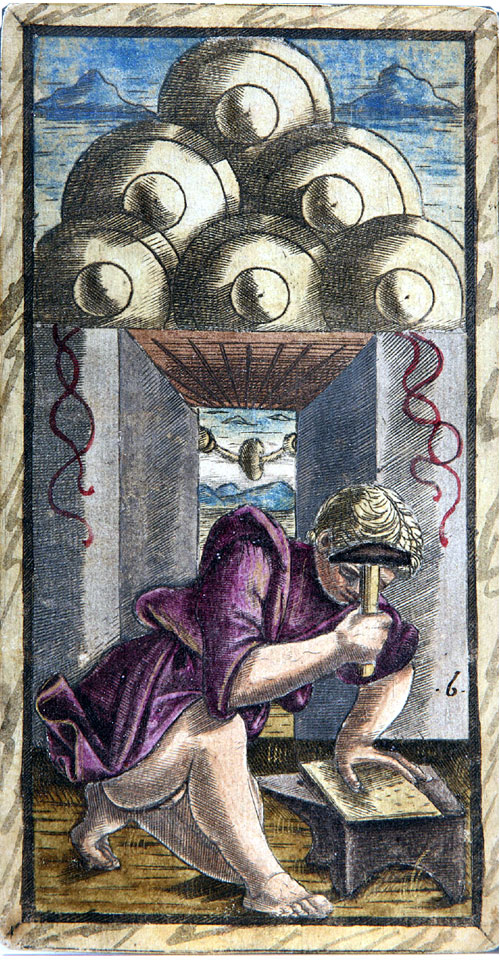
Above: six of discs. Card size = 14.2 x 7.5 cm.
In her book ‘An Introduction to Western Esotericism’ [Edwin Mellen, 2008] Nadya Chishty-Mujahid posits that the Sola Busca tarot could have constituted a mutus liber of esoteric initiation for a secret society such as Pomponio Leto’s Roman Academy. When placed in circular formation the 22 major arcana of the deck display a distinct ritualistic pattern whereby a novice undergoes ritual initiation in order to become a fully tried and tested member of the society. Chishty-Mujahid examines how, when placed in this form, the arcana may definitively be viewed as a type of animated sundial form, with the changes from day to night being clearly delineated and displayed. Since the element of fire is a prevalent one in these major arcana [which show the initiate becoming accomplished in the use of fire and the ability to control it] it is likely that this deck represents figurative illumination; hence the society for which it was used was probably an early form of what later came to be known in Europe as the Illuminati.

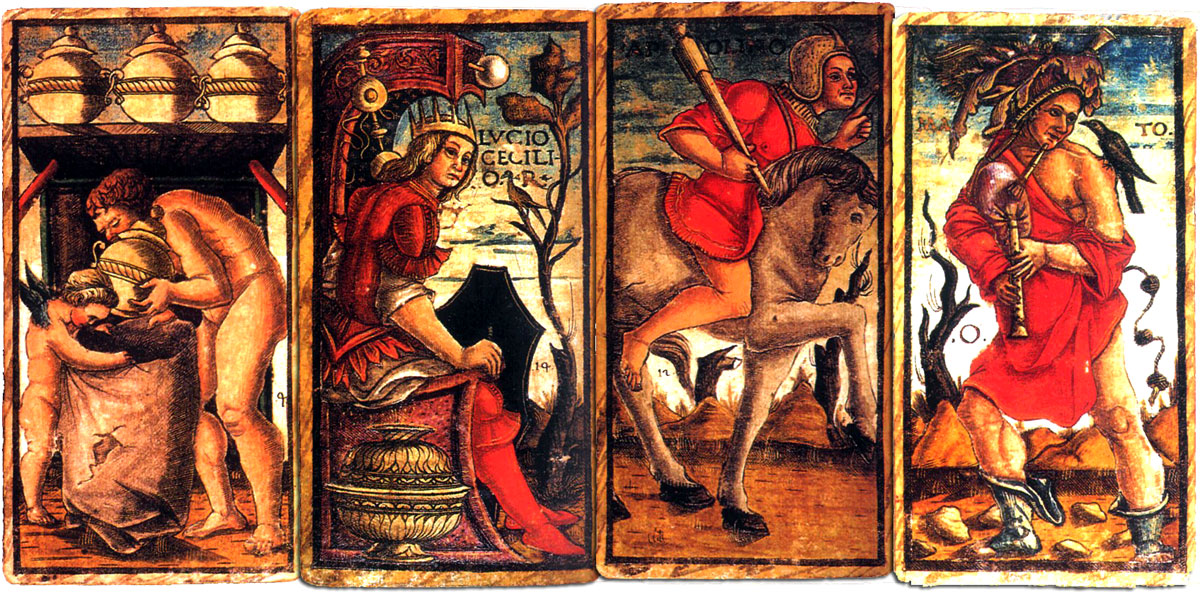
Above: the four of cups with large urns and the artists's distinctive style of nudes. The background landscapes feature low, rounded hills with oddly-shaped trees, often with birds perched in them.
Right: an uncoloured and painted version of the knight of swords, depicting a semi-naked man on horseback wielding an enormous sword, with a scabbard hanging from his waist; a barren, stumpy tree behind.
The artist's sharp and lively lines are often overshadowed by the painting.
Uncoloured version from British Museum, Department of Prints & Drawings Online Collection►
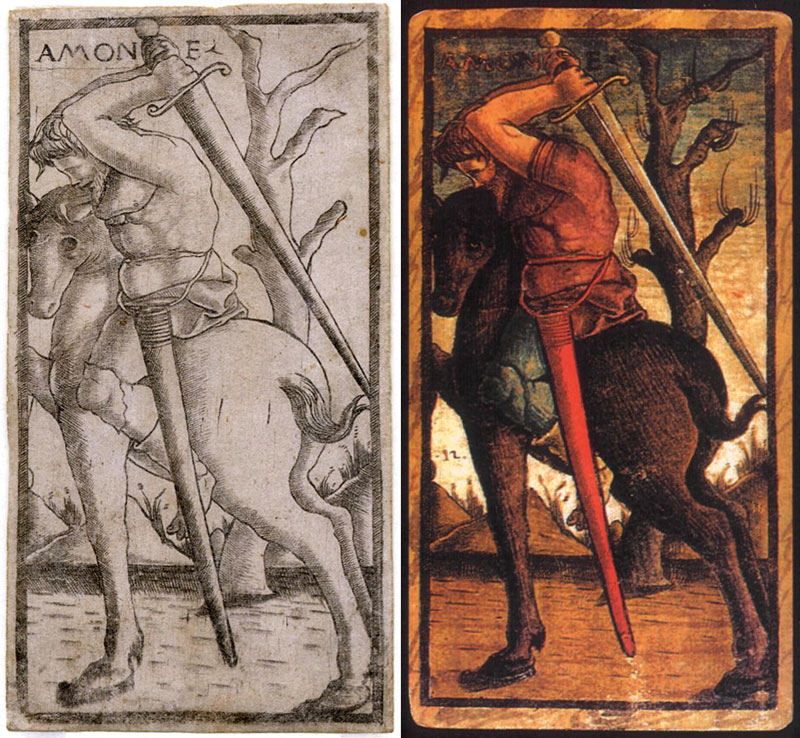
In an article published on the Pinacoteca di Brera website, the author writes “through a decipherment of these images, the [Sola-Busca] deck has been shown to provide a vivid reflection of the kind of alchemical and Hermetic knowledge so dear to the Humanists.” Later in the same article, we read about a “process of inner regeneration that sets out from the exemplars of Illustrious Men of Antiquity, and of contemporary men whom players at the time would no doubt have recognised, and proceeds through various degrees of knowledge – acquired by means of direct enlightenment in a master-pupil relationship.”
Joscelyn Godwin (2002), writing about the so-called Tarocchi di Mantegna, discusses “mapping the hierarchy of being” and “the journey and fate of the soul after death, as taught by Hermetic and Neoplatonic philosophy”. When the soul possesses all the virtues, it is ready to break free of earth and start its ascent through the spheres of the seven heavens. He concludes with “I leave it to others to press these parallels further, in the hope of cracking the code of the Tarocchi — if there is such a code”.
The Game of Saturn: Decoding the Sola-Busca Tarocchi
In his book “The Game of Saturn: Decoding the Sola-Busca Tarocchi” [Scarlet Imprint, 2017], Peter Mark Adams describes how “by the systematic use of ambiguity in the spelling of names and the presence of symbolic counters that point towards deeper, occulted levels of meaning”, the Sola-Busca tarocchi camouflages its true significance as a sequence of ritually themed cards depicting the stages in a pagan theurgical rite.
To illustrate these ideas in his own words, Peter has provided two excerpts from his book and also a podcast interview with Gordon White which was published on 5 Apr 2017:
• Astral Imagery Encoded in Trump XIII Catone►• An Encoded Saturnian Theme►
In spite of the vast trove of research and opinion on the origin of the Tarot, no conclusive evidence has been reached as to who designed the matrix of the “Major Arcana”. Ordinary playing cards probably pre-date the set of 22 trionfi which were added to the tarot deck, yet their enigmatic and striking imagery can be traced back many centuries. Perhaps they represent things that the soul must acquire or master before it is fit to start on the heavenly ladder. This leads us to keep on seeking answers to the question Who had the original vision for the Tarot?
-
Polisena
There was a young woman named Polisena Cavatorta who was a nun in the convent of San Zaccaria when in 1451 her love story with Giovanni Valier came to surface. Polisena had been placed in the convent at a very young age because of a dowry problem. Giovanni met her as a nun but wanted to marry her. After several moonlit walks in the garden and proposals of marrige, they finally made love. Since marriage was not an option they began a lifetime long affair. Soon their baby boy was born at the convent... From: Guido Ruggiero, The Boundaries of Eros: Sex Crime and Sexuality in Renaissance Venice, Oxford University Press, 1985.
➜ the original Sola-Busca queen of cups (Polisena), 1491, and the new re-drawn edition published by Lo Scarabeo, 1995.
In the original (on the left) we can see very clearly the snake in the decorative cup. This is not featured in the modern version.
Click image to ZOOM ➜
So crucial for THE INNER MEANINGS - when the details get corrupted – the totality is lost.
REFERENCES
Adams, Peter Mark: The Game of Saturn: Decoding the Sola-Busca Tarocchi, Scarlet Imprint, 2017. Reviewed here►
Brera, Pinacoteca di: The Sola Busca Deck and the Tarot Game, Milan. Online here►
British Museum: Online Collection►
Chishty-Mujahid, Nadya: An Introduction to Western Esotericism: Essays in the Hidden Meaning of Literature, Groups, and Games, Edwin Mellen Press, 2008
Godwin, Joscelyn: The Pagan Dream of the Renaissance, Thames and Hudson, London, 2002
Pratesi, Franco: In Search of Tarot Sources, The Playing-Card vol.27 No.2 (1998) pp.64-68; No.3 (1999) pp.111-116. Online here►
Zucker, Mark J. : The Master of the Sola-Busca Tarocchi and the Rediscovery of Some Ferrarese Engravings of the Fifteenth Century, Artibus et Historiae, Vol. 18, No. 35, (IRSA s.c. 1997), pp. 181-194.
By Simon Wintle
Spain • Member since February 01, 1996 • Contact
I am the founder of The World of Playing Cards (est. 1996), a website dedicated to the history, artistry and cultural significance of playing cards and tarot. Over the years I have researched various areas of the subject, acquired and traded collections and contributed as a committee member of the IPCS and graphics editor of The Playing-Card journal. Having lived in Chile, England, Wales, and now Spain, these experiences have shaped my work and passion for playing cards. Amongst my achievements is producing a limited-edition replica of a 17th-century English pack using woodblocks and stencils—a labour of love. Today, the World of Playing Cards is a global collaborative project, with my son Adam serving as the technical driving force behind its development. His innovative efforts have helped shape the site into the thriving hub it is today. You are warmly invited to become a contributor and share your enthusiasm.

Leave a Reply
Your Name
Just nowRelated Articles

The Sola-Busca Tarot
Humanist Iconography, Alchemical Metaphor, and the Origins of the Illustrated Minor Arcana.
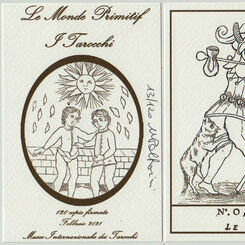
Le Monde Primitif Tarot
Facsimile edition produced by Morena Poltronieri & Ernesto Fazioli of Museo Internazionale dei Taroc...
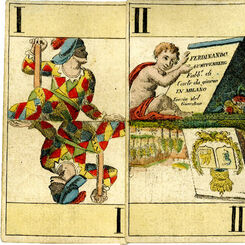
Natural History Tarocchi
Natural History Tarocchi by Ferdinando Gumppenberg, Milan.
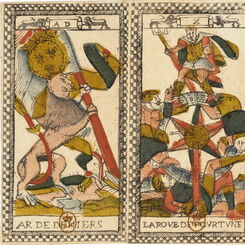
The Parisian Tarot
The “Parisian Tarot”, early 1600s, with imagery and design synthesizing several influences.

V. F. Solesio Tarot
V. F. Solesio Tarot, Genoa, mid-late 19th century.
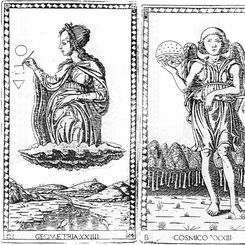
Tarocchi di Mantegna, c.1465
The so-called Tarocchi di Mantegna (c.1465) reflect an ideological structure bringing to mind the so...
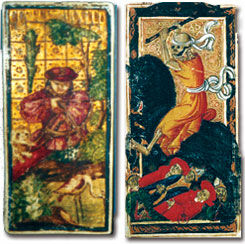
Perspectives on the History of Tarot
From a Renaissance Card Game to a Medium of Spiritual Meaning and Identity.
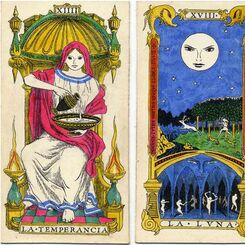
Oliver Mundy tarot
Original Tarot designs in Italian Renaissance style by Oliver Mundy.

Giuseppe Cattino
Playing cards manufactured in Italy by Giuseppe Cattino and Paolo Montanar for Spanish markets.
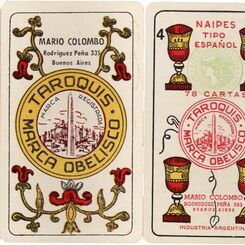
Taroquis ‘Obelisco’
78-card 'Taroquis Marca Obelisco' published by Mario Colombo, Buenos Aires, during the 1950s, 60s & ...

Tarocco Piedmontese by Fabrica de Naipes La Primitiva, Bs Aires
Tarocco Piedmontese by Fabrica de Naipes La Primitiva, Defensa 125, Buenos Aires c.1890.
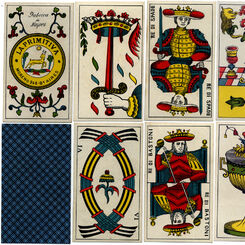
Tarocco Piedmontese, Buenos Aires c.1900
Tarocco Piedmontese by Fabrica de Naipes La Primitiva, Moreno 248, Buenos Aires c.1900

Tarots Egipcios Kier
The “Tarots Egipcios” was first published by Editorial Kier S.A. in c.1971 with Spanish titles, with...
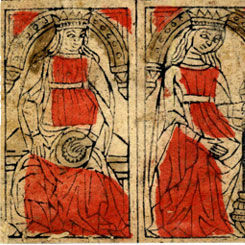
XV Century Italian Playing Cards
Cards from a pack of an early form of north Italian playing cards, with the swords back-to-back and ...

The Visconti-Sforza Tarot, c.1460
This pack of tarot cards appears to have have been made in the Bembo workshop in Cremona for Bianca ...
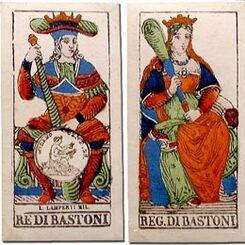
Tarocco Milanesi by Lamperti (Milan) c.1850
Tarocco Milanesi by Lamperti (Milan) c.1850

Sicilian playing cards by Antonio Monasta
"Il Leon" Sicilian playing cards, 40-card pack based on Spanish designs, made in Sicily by Antonio M...
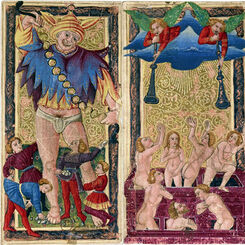
Hand-Painted Tarocchi Cards
Hand-painted Tarocchi cards sometimes known as ‘Charles VI tarot’, North Italy, 1475-1500.
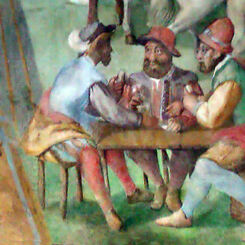
Italian Playing Cards
The first reliable evidence that playing cards were being used in Italy is from 1376, when a game ca...

Playing cards in the Upper Rhine region
Documentary evidence suggests that card playing established itself in Italy in 1376, and then spread...
Most Popular
Our top articles from the past 60 days


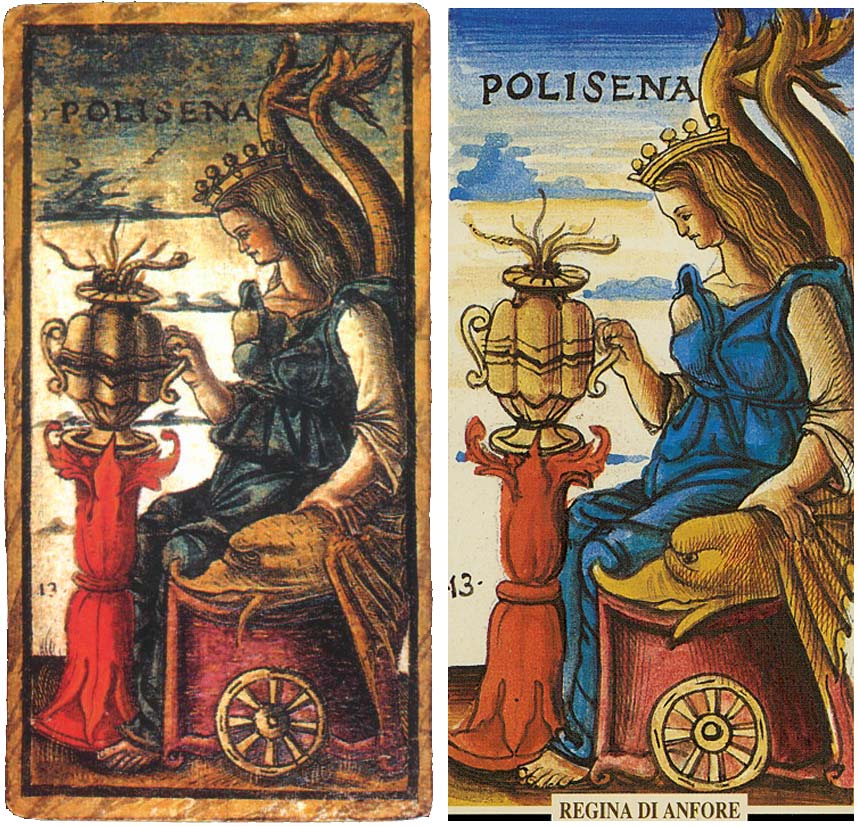
 Your comment here. Your comment here. Your comment here. Your comment here. Your comment here. Your comment here. Your comment here. Your comment here. Your comment here. Your comment here. Your comment here. Your comment here. Your comment here. Your comment here. Your comment here. Your comment here. Your comment here. Your comment here. Your comment here. Your comment here. Your comment here. Your comment here. Your comment here. Your comment here. Your comment here. Your comment here. Your comment here. Your comment here. Your comment here. Your comment here. Your comment here. Your comment here.
Your comment here. Your comment here. Your comment here. Your comment here. Your comment here. Your comment here. Your comment here. Your comment here. Your comment here. Your comment here. Your comment here. Your comment here. Your comment here. Your comment here. Your comment here. Your comment here. Your comment here. Your comment here. Your comment here. Your comment here. Your comment here. Your comment here. Your comment here. Your comment here. Your comment here. Your comment here. Your comment here. Your comment here. Your comment here. Your comment here. Your comment here. Your comment here.




















